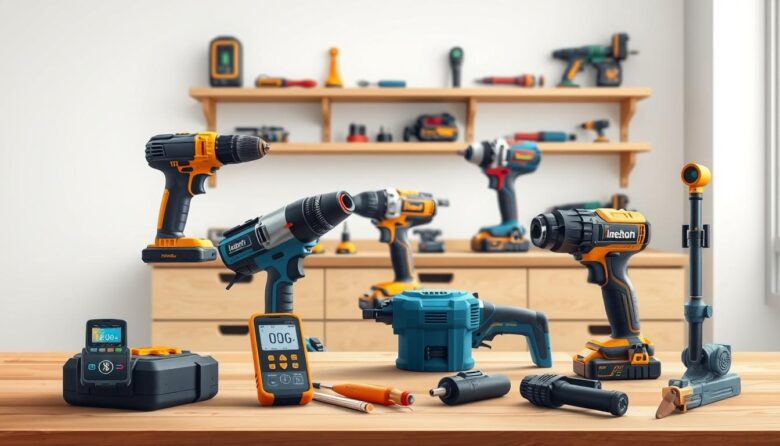The world of do-it-yourself projects is getting a major upgrade. A new generation of equipment is changing how we handle repairs and improvements around the house. These devices bring professional-level features directly to your hands.
Forget about tripping over messy cords or being stuck near an outlet. Modern gear offers complete freedom of movement. You can work anywhere in your space while staying connected to your smartphone or tablet.
This integration combines traditional power and reliability with advanced wireless technology. Users gain remote monitoring, precise control, and enhanced safety. These were features once only found in high-end professional equipment.
From drills with app-adjusted settings to speakers for your workspace, the convenience is real. The best options deliver this smart functionality without sacrificing battery life or rugged durability. It’s crucial to know which innovations offer true value for your projects.
Introduction to Bluetooth Home Tools
Modern maintenance has evolved beyond basic manual implements to incorporate intelligent technology. These advanced solutions combine physical capability with digital intelligence for superior results.
Exploring the Rise of Smart Home Repair Devices
The integration of wireless technology represents a fundamental shift in maintenance approaches. Real-time data transmission and remote diagnostics now enhance traditional methods.
Smart connectivity transforms standard equipment into intelligent systems. These innovations communicate with mobile applications for detailed performance metrics.
Maintenance reminders and troubleshooting guidance appear directly on smartphones. This evolution reflects broader trends in interconnected technology ecosystems.
Why Bluetooth Connectivity Matters
Wireless communication eliminates complex wiring requirements while providing reliable performance. Low-energy transmission extends operational duration significantly.
Modern enabled devices offer compatibility with existing equipment while supporting future upgrades. This ensures long-term relevance for technology investments.
The ability to pair multiple units with a single mobile device creates centralized control. This streamlines project management and maintenance scheduling effectively.
Understanding the Role of Bluetooth in DIY Home Repairs
Two major advancements have reshaped the capabilities of repair equipment available to today’s DIY enthusiast. The initial shift brought mobility through cordless designs, while the latest innovation adds intelligent connectivity.
The Evolution from Corded to Cordless Systems
The transition to cordless equipment marked a fundamental change in project flexibility. Early wireless models often compromised on performance for the sake of portability. Modern technology has eliminated these limitations.
Today’s cordless tools deliver impressive power that rivals traditional corded alternatives. Advanced battery technology provides extended runtime without sacrificing capability. This represents a significant improvement over earlier generations.
Intelligent features now enhance the core cordless design. Equipment can communicate vital information like charge levels and maintenance needs. This proactive approach prevents unexpected interruptions during critical project phases.
Precision control has evolved beyond basic switches. Users can fine-tune settings through connected applications, achieving professional-grade results. The entire system works harmoniously to optimize performance and efficiency.
Understanding this progression helps maximize equipment potential. Proper management of wireless resources ensures reliable operation throughout any repair task. The combination of mobility and intelligence creates a powerful advantage.
Key Features and Performance Metrics
Performance assessment goes beyond basic specifications to include practical operational characteristics. Understanding these metrics helps users select equipment that delivers consistent results in real-world conditions.
The most valuable features combine intelligent design with reliable functionality. This approach ensures equipment performs effectively during demanding projects.
Battery Life and Power Efficiency
Extended runtime remains a critical factor for wireless equipment. Modern devices achieve impressive battery life through intelligent energy management systems.
Sophisticated circuitry minimizes wasted energy during operation. This power efficiency ensures connectivity features add minimal drain to overall consumption.
LED Indicators and Signal Feedback
Advanced visual systems provide immediate status information. These led light indicators communicate battery levels and connection strength instantly.
Color-coded patterns offer detailed diagnostic alerts without interrupting workflow. This led feedback system enhances user awareness during operation.
Comparing Top-Rated Bluetooth Audio Receivers
Choosing the right wireless audio receiver involves balancing performance features with budget considerations. Two standout products demonstrate the range of options available to consumers.
These devices transform traditional sound systems into modern wireless setups. The comparison focuses on key performance metrics and value.
Premium Option: iFi Audio Zen Air Blue
The iFi Audio Zen Air Blue represents the high-end segment with exceptional audio quality. This unit delivers impressive sound output through its advanced digital-to-analog converter.
It maintains reliable connection across substantial range, passing through multiple walls. The product includes vocal confirmation of device pairing and active codec details.
Setup requires additional cables not included in the package. Users should factor this into the total price when planning their system.
Budget Pick: 1Mii B06 Plus
The 1Mii B06 Plus offers remarkable value at an affordable price point. This budget-friendly unit includes essential accessories like a power adapter.
It features a physical power button for better control over device connections. The sound quality competes with more expensive options when used with compatible devices.
Construction materials reflect the lower price but don’t compromise core functionality. This product proves satisfying wireless audio doesn’t require significant investment.
Integrating Bluetooth Tools into Your Home Repair Workflow
The transition to smart-enabled gear involves more than just purchasing new devices—it requires workflow adaptation. Successful integration demands thoughtful planning around pairing sequences and charging schedules.
Initial setup goes beyond simple unboxing. Consider smartphone storage for companion apps and establish backup pairing with secondary devices. This ensures productivity continues when primary phones are unavailable.
Creating efficient work systems means establishing protocols for routine firmware updates. Manufacturers release these to improve connectivity stability and add features. Regular updates prevent compatibility issues with newer operating systems.
The process works best when implemented gradually. Start with less critical equipment to develop familiarity with wireless features. Then transition to app-based controls for essential functions.
Workflow optimization includes organizing digital inventories within apps. Set customized operational profiles for different project types. Establish maintenance reminders to prevent equipment failures during critical repairs.
Understanding how integration affects your overall repair process helps identify which equipment benefits from wireless connectivity. Some applications may still work better with traditional operation methods.
Advantages of Cordless & Portable Bluetooth Systems
Unrestricted mobility stands as one of the most significant benefits of modern equipment designed for dynamic work environments. These systems eliminate traditional constraints that limited equipment placement and workflow efficiency.
Mobility and Ease of Setup
Cordless systems deliver unmatched freedom for positioning equipment exactly where needed. Setup becomes incredibly simple without extension cord requirements or outlet location concerns.
Major manufacturers like Milwaukee, DeWalt, and Makita design their portable units for quick deployment. Workers can begin productive activities within seconds of arriving at the location.
Long Battery Life Benefits for Jobsite Use
Extended runtime represents a critical advantage for professional applications. Leading models provide 8-12 hours of continuous operation per charge using standard battery platforms.
This impressive battery life ensures all-day functionality without mid-shift interruptions. Some units achieve 20+ hours per charge at moderate volume levels.
The long battery performance justifies investment through reduced downtime and enhanced reliability. Users can focus on repair work rather than monitoring charge levels during critical projects.
Overcoming Signal Challenges with Advanced Bluetooth Technology
Achieving consistent signal strength throughout your workspace requires understanding how advanced protocols handle interference. Modern wireless systems employ sophisticated technology to maintain reliable connections even in challenging environments.
Premium equipment demonstrates impressive range capabilities, maintaining stable connections through multiple walls. These systems can cover entire residential spaces without signal degradation.
Optimizing Indoor Connectivity
Building materials significantly impact wireless transmission. Drywall and wood framing present minimal obstacles, while concrete and metal studs can attenuate signals. Strategic placement of receivers in central locations enhances overall system performance.
Advanced antenna designs and signal processing algorithms help avoid interference from other devices. This ensures reliable audio quality and data transmission throughout your projects.
Understanding real-world performance versus ideal specifications helps set proper expectations. Implement these strategies for dependable wireless operation in any environment.
Smart Features and App Integration for Enhanced Control
The true power of modern wireless systems emerges when smartphone integration unlocks advanced configuration options. Companion applications transform basic connectivity into sophisticated control centers.
These digital interfaces provide granular adjustments that physical controls cannot match. Users gain unprecedented customization capabilities through intuitive mobile interfaces.
Customizing Audio Output and Device Pairing
Mobile applications enable precise audio output adjustments including equalization and volume limiting. This level of control optimizes sound quality for specific listening environments.
The iFi Audio Zen Air Blue demonstrates premium integration with verbal connection confirmation. Its always-on mode and LED indicators provide immediate status feedback without app dependency.
Advanced pairing management through companion app interfaces maintains profiles for multiple devices. Automatic priority switching seamlessly transfers control between connected equipment.
Mode selection features accessible through digital interfaces serve diverse applications. Users can toggle between low-latency gaming and high-fidelity audiophile settings.
Physical button controls remain essential for reliable fallback operation. The 1Mii B06 Plus includes dedicated power and 3D Surround mode buttons for instant adjustments.
This integration represents the pinnacle of wireless audio system sophistication. Comprehensive app control elevates user experience beyond basic connectivity.
Durability and Performance on the Jobsite
The harsh conditions of active construction sites separate durable professional gear from consumer-grade alternatives. Industrial-rated equipment must withstand impacts, dust, moisture, and temperature extremes that would quickly disable standard electronics.
Leading manufacturers like Milwaukee, DeWalt, and Makita design their units for seamless integration with battery and storage systems. This creates comprehensive platforms where various devices share common ecosystems.
The rugged construction of professional equipment includes reinforced housings and protective roll cages. Sealed control panels and impact-resistant screens enable survival of inevitable drops and collisions.
Power management prioritizes runtime reliability over maximum output. Conservative ratings ensure consistent performance throughout entire work shifts rather than impressive specs that drain batteries prematurely.
Professional-grade units undergo rigorous testing simulating years of jobsite abuse. Drop tests, water immersion, and thermal cycling validate durability claims before commercial availability.
This investment delivers long-term value through extended service life and maintained performance standards. The equipment justifies premium pricing compared to consumer alternatives requiring frequent replacement.
Cost vs. Performance: Evaluating Price Points
The relationship between investment level and operational benefits becomes clear when comparing entry-level and premium options. Market prices reflect genuine capability differences across various equipment categories.
Price stratification reveals distinct performance tiers. Budget units under $50 offer basic connectivity, while premium products above $100 deliver superior audio fidelity and extended range.
Value of Investment in High-Quality Bluetooth Tools
Premium equipment justifies its higher price through enhanced durability and consistent performance. The iFi Audio Zen Air Blue at approximately $100 provides comprehensive codec support and exceptional connection stability.
Budget alternatives like the 1Mii B06 Plus under $30 deliver adequate sound quality despite simpler construction. However, they may require additional accessory purchases.
Professional-grade units from Milwaukee, DeWalt, and Makita command $150-$350 prices. These products feature weather resistance and battery system integration essential for commercial applications.
Understanding total ownership costs reveals better long-term value from premium investments. Reduced replacement frequency and superior warranty coverage offset initial price differences.
The sweet spot for most users falls around $150-$200. This range offers professional construction and reliable connectivity without diminishing returns of flagship models.
Essential Accessories and Setup Tips
Many users overlook the importance of complementary accessories when setting up their systems. The right components ensure reliable performance and prevent common installation issues.
Choosing the Right Cables and Chargers
Proper cable selection impacts your audio quality significantly. High-quality stereo RCA interconnects maintain signal integrity between receivers and amplification systems.
The iFi Audio Zen Air Blue requires separate purchase of cables and a USB wall charger. This unit can draw power from USB ports on compatible audio components.
In contrast, the 1Mii B06 Plus includes essential accessories. However, dedicated RCA cables provide more secure connection than included adapters.
Pay attention to power supply specifications. Some equipment needs specific voltage ratings that generic chargers may not provide.
Proper setup involves understanding your equipment’s options. Consider button placement for easy access during daily operation.
For battery-powered equipment, establish charging stations and spare battery systems. This ensures continuous availability during extended projects.
Review all technical details before purchasing accessories. These details prevent common mistakes that could void warranties.
Corded backup options provide reliability when battery power depletes. Many professional units support both wireless and corded operation.
The physical button controls on each unit should be easily accessible. Consider this during your initial setup planning.
Always check the manufacturer’s specifications for accessory requirements. These details ensure optimal performance from your equipment.
Real-World User Experiences and Practical Insights
User testimonials provide invaluable insights that specifications sheets cannot capture about equipment functionality. These firsthand accounts reveal how wireless systems perform under actual working conditions.
Feedback from DIY Enthusiasts
Field testing consistently shows that advertised range specifications often fall short in residential environments. Users report effective connection distances are typically 30-50% shorter than claimed values.
Battery performance emerges as a critical satisfaction factor for any wireless product. Units delivering 8+ hours of operation receive consistent praise from work site users.
The integration process proves more complex than many anticipate. Reliable pairing and automatic reconnection significantly impact whether the tool enhances or complicates daily operations.
Durability often outweighs audio quality for outdoor projects. Even modest sound performance satisfies when equipment withstands dust, moisture, and impacts common on active job sites.
Ecosystem compatibility greatly influences user satisfaction. Contractors using Milwaukee, DeWalt, or Makita battery systems prefer speaker units that share the same power platform.
Key Takeaways for Smarter Home Repairs
Making the right choice in wireless equipment for your projects comes down to understanding value versus cost. Budget-friendly options under $50 work well for casual use, while professional-grade units costing $150-$300 offer superior durability and reliability.
The Milwaukee M18 system represents the premium standard for worksite integration. These products provide exceptional build quality and seamless compatibility with comprehensive cordless platforms.
Battery-powered devices deliver maximum value when integrated with existing systems. Users with substantial DeWalt 20V Max or Makita 18V LXT battery stock can power speakers without extra investment.
Manage expectations around wireless range, as real-world performance typically provides 30-50 feet of effective distance. This remains adequate for most residential project requirements.
Essential features prioritize reliability over sophistication. Consistent pairing, physical button controls, and adequate battery life prove more valuable than advanced app integration for most repair work.
The sweet spot for quality and price currently sits around $150-$200. This range offers professional durability and satisfying audio output without the diminishing returns of flagship models.



